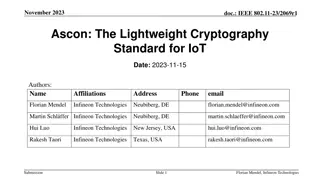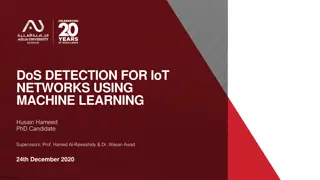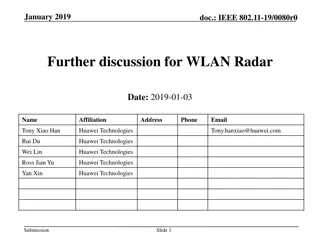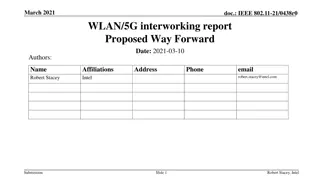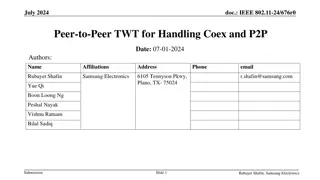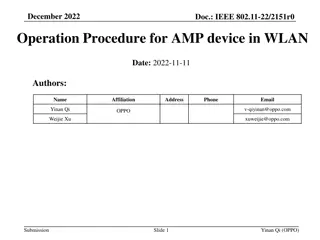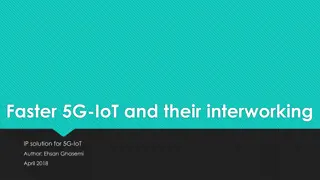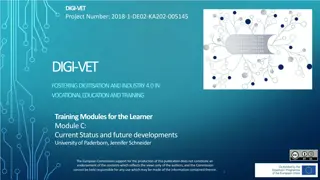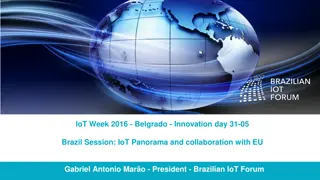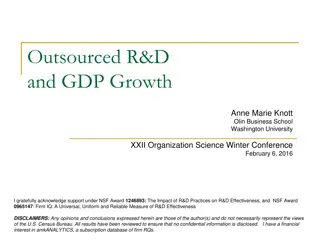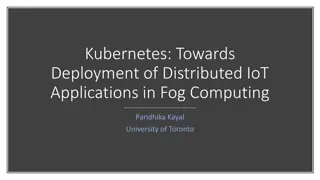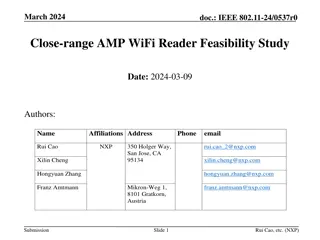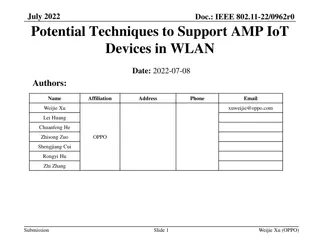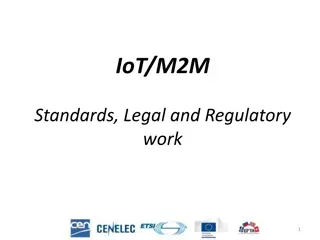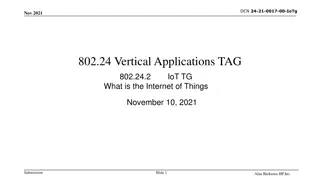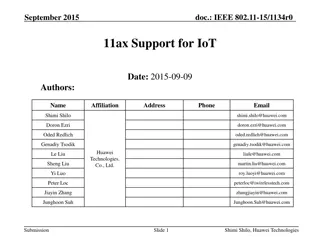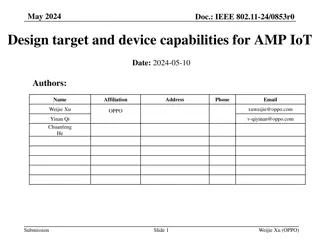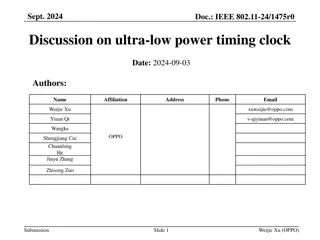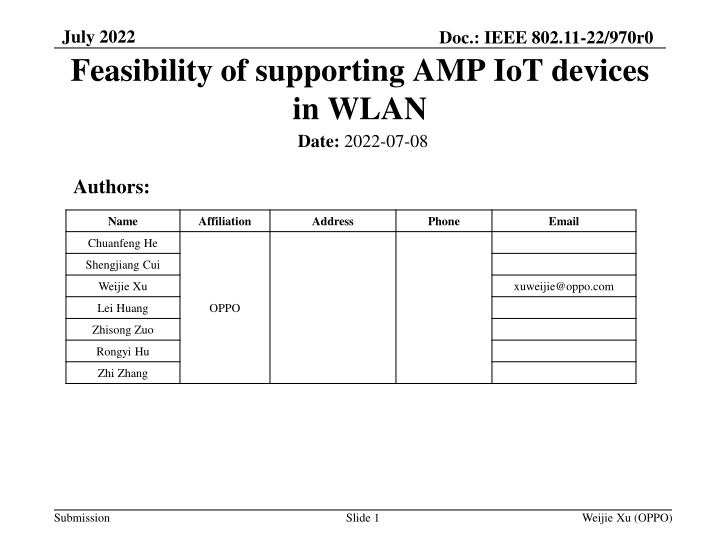
Feasibility of Supporting AMP IoT Devices in WLAN
This document explores the feasibility of supporting AMP IoT devices in WLAN by analyzing link budgets, constraints from energy harvesting, and various scenarios for different types of IoT devices. It discusses parameters like frequency, EIRP, receiver sensitivity, antenna gain, and communication distances, shedding light on the challenges and possibilities in integrating AMP IoT devices into WLAN environments.
Download Presentation

Please find below an Image/Link to download the presentation.
The content on the website is provided AS IS for your information and personal use only. It may not be sold, licensed, or shared on other websites without obtaining consent from the author. If you encounter any issues during the download, it is possible that the publisher has removed the file from their server.
You are allowed to download the files provided on this website for personal or commercial use, subject to the condition that they are used lawfully. All files are the property of their respective owners.
The content on the website is provided AS IS for your information and personal use only. It may not be sold, licensed, or shared on other websites without obtaining consent from the author.
E N D
Presentation Transcript
July 2022 Doc.: IEEE 802.11-22/970r0 Feasibility of supporting AMP IoT devices in WLAN Date: 2022-07-08 Authors: Name Affiliation Address Phone Email Chuanfeng He Shengjiang Cui Weijie Xu xuweijie@oppo.com Lei Huang OPPO Zhisong Zuo Rongyi Hu Zhi Zhang Submission Slide 1 Weijie Xu (OPPO)
July 2022 Doc.: IEEE 802.11-22/970r0 Outline Link budget for different AMP IoT device types Constraint from energy harvesting Data rate Coexistence Summary Reference Submission Slide 2 Weijie Xu (OPPO)
July 2022 Doc.: IEEE 802.11-22/970r0 Link budget for different AMP IoT device types (1) Link budget for AMP-only IoT device with backscatter transmitter Three cases are evaluated: case1/2 (energy harvested from radio waves) and case 3 (energy harvested from light). Case1 Case2 Case3 920 920 920 Frequency (MHz) EIRP of AP (dBm) 30 30 30 Receiver sensitivity of AP (dBm) -95 (Note 1) -95 -95 Antenna gain of IoT device (dBi) 2 2 2 Minimum receiving power for IoT device (dBm) Maximum communication distance from AP to IoT device (m) Backscattering loss at IoT device (dB) Low Noise Amplifier factor (dB) Maximum communication distance from IoT device to AP (m) *Notes: (1) Reuse the receiver sensitivity of 802.11 ah AP (2) The minimum required signal power for an IoT device is -20dBm when the IoT device can t store power itself. It can be -30dBm when the IoT device has the capability of power storage. (3) -45 dBm is assumed as the sensitivity of ultra-low power receiver [1][2][3]. (4) LNA with 30 dBm gain is assumed to boost the backscattering signal, it can have ultra-low power consumption [4][5]. -20 (Note 2) 10.33 5 0 103.31 -30 (Note 3) 32.67 5 0 32.67 -45 (Note 4) 183.71 5 30 (Note 3) 183.71 Submission Slide 3 Weijie Xu (OPPO)
July 2022 Doc.: IEEE 802.11-22/970r0 Link budget for different AMP IoT device types (2) Link budget for AMP-only IoT device with active transmitter Case4 920 Frequency (MHz) EIRP of AP (dBm) 30 Receiver sensitivity of AP (dBm) -95 Antenna gain of IoT device (dBi) 2 Minimum receiving power for IoT device (dBm) Maximum communication distance from AP to IoT device (m) Maximum transmission power of IoT device (dBm) Maximum communication distance from IoT device to AP (m) *Notes: (1) Ultra-low power active transmitter is assumed[6][7][8]. -45 183.71 -15(Note 1) 259.49 Submission Slide 4 Weijie Xu (OPPO)
July 2022 Doc.: IEEE 802.11-22/970r0 Constraints from energy harvesting The typical power from ambient power source is summarized as in following table1: Table 1. Energy harvesting sources [9] [10]. Energy source Type Typical power 100 mW/cm2(outdoor), 100 W/cm2(artificial light) 10 mW/cm2(filtered solar light) 1uw~100uw Outdoor solar light Indoor office light Natural Artificial/natural Radio frequency Artificial 60 W/cm2 Thermoelectric Vibration Artificial Artificial 4 W/cm3(human motion) 800 W/cm3(machines) 1 mW/cm2 960 nW/cm3 Ambient airflow Acoustic noise Natural/artificial Natural/artificial It can be observed the output power harvested from various power sources is very limited, e.g. from 1uW to 100mW(per cm2/cm3). Due to small form factor of AMP-only IoT device, it is required to support maximum power consumption of around 1mW. Submission Slide 5 Weijie Xu (OPPO)
July 2022 Doc.: IEEE 802.11-22/970r0 Data rate For AMP-only IoT device, narrow bandwidth is assumed for data transmission: 31.25kHz*N for 1 MHz and 2 MHz channel in Sub 1GHz, N = 2,4,8 etc. 312.5kHz*N for 20 MHz channel in 2.4 GHz (if supported), N = 2,4,8 etc. Encoding Rate R=1/2,1/4 Band/Channel S1G/1M S1G/2M S1G/1M S1G/2M 2.4G/20M Signal Bandwidth 31.25kHz*2 31.25kHz*8 31.25kHz*2 31.25kHz*4 312.5kHz*2 312.5kHz Symbol Duration 20 s 5 s 20 s 10 s 2 s 4 s Equivalent Information Bit Duration 40 s 10 s 80 s 40 s 4 s 16 s R 1/2 1/2 1/4 1/4 1/2 1/4 Data rate 25kb/s 100kb/s 12.5kb/s 25kb/s 250kb/s 62.5kb/s Note 1: 20% Guard interval duration in a symbol duration Submission Slide 6 Weijie Xu (OPPO)
July 2022 Doc.: IEEE 802.11-22/970r0 Coexistence (1) Potential AMP PPDU format can be introduced to facilitate backward compatibility. For AMP-only IoT devices operating in Sub 1GHz AMP PPDU format contains 802.11ah preamble (e.g. including LTF, STF, SIG portion), followed by AMP portion. For AMP-only IoT devices operating in 2.4GHz AMP PPDU format contains legacy preamble (e.g. L-STF, L-LTF, L-SIG, followed by AMP portion. The transmission bandwidth of AMP specific fields can be narrower than that of the preamble. Simple waveform will be adopted for AMP portion. example AMP PPDU format PPDU Preamble for backward compatibility AMP preamble AMP header Payload AMP portion Submission Slide 7 Weijie Xu (OPPO)
July 2022 Doc.: IEEE 802.11-22/970r0 Coexistence (2) It would be a challenge for AMP-only IoT device to generate the preamble due to required OFDM waveform. Backscattering can be one option to tackle the preamble transmission issue. AMP-only IoT device backscatters the preamble, which is provided by the AP Immediately after the preamble, the AMP-only IoT device transmits the AMP portion. Therefore, as a whole the proposed AMP PPDU format can be transmitted by the AMP-only IoT device. ... ... Carrier Preamble Carrier AMP IoT Device Backscattering AP ... AMP Portion Preamble ... Submission Slide 8 Weijie Xu (OPPO)
July 2022 Doc.: IEEE 802.11-22/970r0 Coexistence (3) It may be difficult for an AMP-only IoT device to perform channel access due to its ultra-low power and low complexity receiver May not be able to perform CCA and set the NAV May not be able to support EDCA protocol Triggered UL access mechanism can be used for AMP-only IoT device for UL transmission. AP may transmit a Trigger frame to an AMP-only IoT device to solicit UL transmission Submission Slide 9 Weijie Xu (OPPO)
July 2022 Doc.: IEEE 802.11-22/970r0 Summary This presentation discusses the feasibility of supporting AMP IoT devices in WLAN, focusing on the following aspects Link budget for different AMP IoT device types Constraint from energy harvesting Data rate Coexistence Based on the discussion, it can be seen that although there is power constraint from energy harvesting, requirements such as the communication distance, power consumption and data rata etc. can be fulfilled by using ultra-low power backscattering transmitter (or ultra-low power active transmitter ) and ultra-low power receiver. Submission Slide 10 Weijie Xu (OPPO)
July 2022 Doc.: IEEE 802.11-22/970r0 Reference 1. J. Im, H. -S. Kim and D. D. Wentzloff, "A 470 W 92.5dBm OOK/FSK Receiver for IEEE 802.11 WiFi LP-WUR," ESSCIRC 2018 - IEEE 44th European Solid State Circuits Conference (ESSCIRC), 2018, pp. 302-305, doi: 10.1109/ESSCIRC.2018.8494331. 2. J. Im, H. Kim and D. D. Wentzloff, "A 217 W 82dBm IEEE 802.11 Wi-Fi LP-WUR using a 3rd- Harmonic Passive Mixer," 2018 IEEE Radio Frequency Integrated Circuits Symposium (RFIC), 2018, pp. 172-175, doi: 10.1109/RFIC.2018.8428988. 3. R. Liu et al., "An 802.11ba-Based Wake-Up Radio Receiver With Wi-Fi Transceiver Integration," in IEEE Journal of Solid-State Circuits, vol. 55, no. 5, pp. 1151-1164, July 2020, doi: 10.1109/JSSC.2019.2957651. 4. J. Kimionis, A. Georgiadis, Sangkil Kim, A. Collado, K. Niotaki and M. M. Tentzeris, "An enhanced-range RFID tag using an ambient energy powered reflection amplifier," 2014 IEEE MTT-S International Microwave Symposium (IMS2014), 2014, pp. 1-4, doi: 10.1109/MWSYM.2014.6848653. 5. D Matos, R Correia,NB Carvalho, Dual-Band FET-Based Reflection Amplifier for Backscatter Modulator Performance Enhancement URSI Radio Science Letters, 2021 6. K. Tang et al., "A 75.3 pJ/b Ultra-Low Power MEMS-Based FSK Transmitter in ISM-915 MHz Band for Pico-IoT Applications," 2021 IEEE International Symposium on Circuits and Systems (ISCAS), 2021, pp. 1-4, doi: 10.1109/ISCAS51556.2021.9401715 7. M. S. Jahan, J. Langford and J. Holleman, "A low-power FSK/OOK transmitter for 915 MHz ISM band," 2015 IEEE Radio Frequency Integrated Circuits Symposium (RFIC), 2015, pp. 163-166, doi: 10.1109/RFIC.2015.7337730. 8. J. Bae and H. Yoo, "A low energy injection-locked FSK transceiver with frequency-to-amplitude conversion for body sensor applications," 2010 Symposium on VLSI Circuits, 2010, pp. 133-134, doi: 10.1109/VLSIC.2010.5560325. 9. N. Dang, E. Bozorgzadeh and N. Venkatasubramanian, "Chapter 6 -Energy Harvesting for Sustainable Smart Spaces" in Advances in Computers., Elsevier, vol. 87, pp. 203-251, 2012. 10. Energy harvesting technologies[M]. New York: Springer, 2009. Submission Slide 11 Weijie Xu (OPPO)

